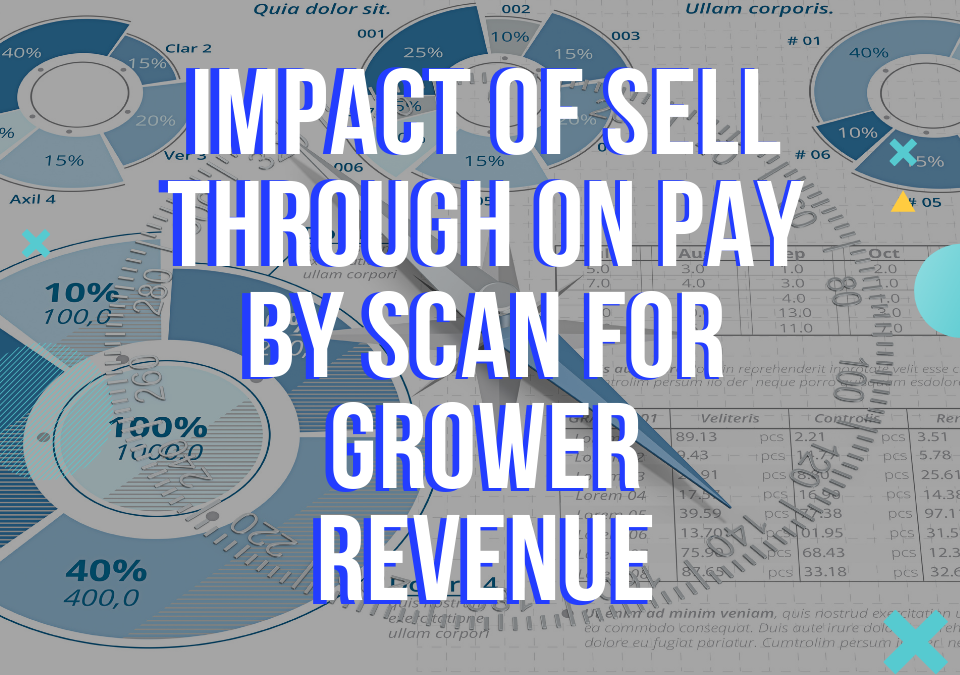
What to Expect When Onboarding Your New AGS Grower Software
March 10, 2022
Have You Backed Up Your Data? … Are You Sure?
April 8, 2022Growers who are engaged in the “Pay by Scan” or “Pay from Scan” model who price their products without accounting for the impact of sell through can put themselves in economic difficulty. Correctly anticipating sell through and accounting for it in pricing can overcome one of the barriers to a successful pay by scan program.
Sell Through
Sell through is the ratio of sold to shipped, expressed as a percentage of either units or dollars. So, you can calculate sell through units or sell through dollars.
Sell through units show how effective the store was at moving the units delivered and sell through dollars shows how effective the store was at moving the full retail value of the units.
Unit Sell Through Example:
If you ship 10,000 units to a store and you end up getting sales for 8,345 and the rest must be scrapped (shrink) then your unit sell through is:
8,345/10,000 = 83.45% unit sell through.
Unit sell through is not the only part to consider, however.
Dollar Sell Through Example:
If your retailer does ‘markdown’ programs, that is to discount items that are not moving or of marginal quality or to make room for different stock at the season boundaries, then your financial results may be different.
Example:
If you shipped 10,000 units to a store and you ended up selling 10,000 units your unit sell through is 100%. However, if some of those sold due to markdown your dollar sell through is different.
| Sales Units | Percent of Sales | Sale Price |
| 6,500 | 65% | $ 13.99 |
| 2,500 | 25% | $ 10.00 |
| 1,000 | 10% | $ 8.00 |
| 10,000 | 100% | $ 12.39 |
Table 1 shows the percent of sales for these 10,000 units at each price tier of the markdown program. As you can see the weighted average price was $12.39, not the $13.99 you were expecting. Thus, the total value of the program (10,000 * $13.99 = $139,900) realized only $123,900 in revenue (10,000 * $12.39) to the grower. In this example the markdown program cost the supplier $15,100 even through it gave them 100% unit sell through.
The sell through is shown in the table below.
| Units | Price | Value | |
| Delivered | 10,000 | $ 13.99 | $ 139,900 |
| Sold | 10,000 | $ 12.39 | $ 123,900 |
| Sell Through | 100% | 89% | 89% |
In this example the grower had a super unit sell through, 100%, but a dollar sell through of 89%.
Typically, however, in these situations your unit sell through is never 100% with perishable items.
Effect of unit and dollar sell through working together on grower revenue
Example:
If you shipped 10,000 units to a store and you had a less than 100% unit sell through with a markdown program it would be like this.
| Sales Units | Percent of Sales | Sale Price | Revenue |
| 5,325 | 63% | $ 13.99 | $74,497 |
| 2,251 | 27% | $ 10.00 | $25,510 |
| 769 | 10% | $ 8.00 | $6,152 |
| 8,345 | 100% | $ 12.36 | $103,159 |
In this case the grower sold 8,345 units at an average selling price of $12.36 through the markdown program.
With that markdown and sales scenario lets look at the sell through impact:
| Units | Price | Value | |
| Delivered | 10,000 | $ 13.99 | $ 139,900 |
| Sold | 8,345 | $ 12.36 | $ 105,174 |
| Sell Through | 83% | 88% | 74% |
In this case you can see that the 83% sell through, coupled with the 88% average selling price yields a 74% dollar sell through. In this case it would have cost the grower $36,741.
Know Who Loses is the Markdown Program
One thing a grower needs to understand in a markdown program with a given retail is where does the discount come from? If a delivered item is discounted does the discount value all come from the grower’s margin, thus keeping the retailer’s margin intact? Or does the retailer also bear some of the ‘cost’ of the markdown, or is the discount all on the retailer? Different retailers or programs may handle this in different ways.
If you are a grower selling into a Pay by Scan retailer and your program requires that you take the loss on a markdown you need to carefully consider the effects of markdown.
Example:
Let’s say a grower has shipped 10,000 units at a $14.99 retail to a store where the wholesale price is $11.00, and the grower’s cost is $7.50 per unit. The table below shows the desired scenario:
| Delivered | Retail | Wholesale | Cost | |
| Price | $14.99 | $11.00 | $7.50 | |
| Units | 10,000 | 10,000 | 10,000 | |
| Revenue | $149,900 | $110,000 | $75,000 | |
| Margin | 27% | 32% | N/A | |
| Margin $ | $39,900 | $35,000 | N/A |
In this case with a 100% sell through and no markdown the grower plans on a 32% margin and $35,000 in gross profit on this item program.
Let’s assume that for this retailer the grower must keep the retailer’s margin whole and uses a markdown program to achieve sell thru. In this case, the unit sell thru has some shrink for a Sell Thru of 83.45%. But to achieve that they had to do a markdown program that resulted in a weighted average price of $13.27.
| Sold | Retail | Wholesale | Cost | |
| Price | $13.27 | $9.69 | $7.50 | |
| Units | 8,345 | 8,345 | 10,000 | |
| Value | $110,738 | $80,839 | $75,000 | |
| Price Margin | 27% | 23% | N/A | |
| Price Margin $ | $3.58 | $2.19 | N/A | |
| Total Margin $ | $29,899 | $5,839 | N/A | |
| Effective Margin | 27% | 7% | N/A |
In this example you can see that if the grower checks the price-based margin after markdown they would see a 23% margin. However, since the grower bears all the cost of the full 10,000 delivered units the actual realized margin in this example is 7%. In this case the growers margin varied -77% from their original plan.
In other words, the markdown program coupled with the retailer policy of keeping their margin whole can yield a very different financial result for the grower in cases where the unit sell reduction is coupled with a markdown.
Granted many growers would say that some dollars are better than no dollars, and while this is true, the important point is that the grower does need to be able to model the effect of a markdown / lower unit sell through to price their products and negotiate the programs with the retailers more effectively.
Learn more about the Pay by Scan model arrangement between growers and big-box retailers as well as information on software capabilities needed for this model and key factors for success. Read the Pay by Scan Playbook here.
Advanced Grower Solutions can help you in your pricing. We can provide data analysis and consulting. Contact us today to find out how.





